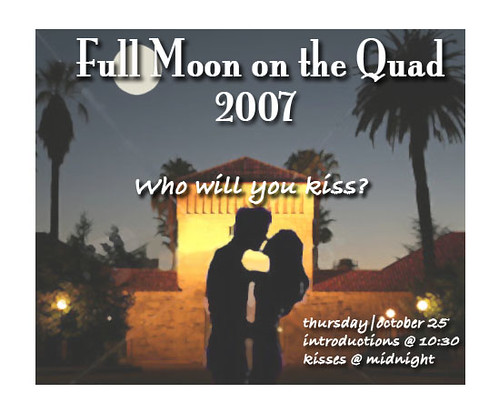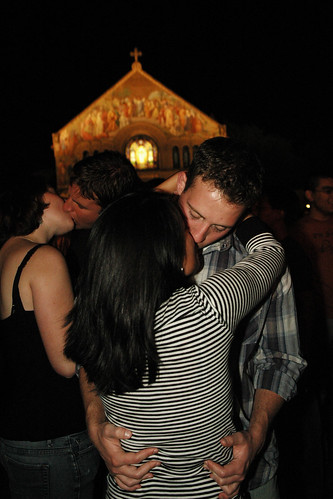 Heidi Durrow is coming to the Bay Area this week to read from her debut novel, The Girl Who Fell from the Sky, and sign copies of the book. She’ll be at the Stanford University Bookstore on Wednesday, April 7, and at Kepler’s Books in Menlo Park on Thursday, April 8. Full details are below. You’ll note that both Stanford and Kepler’s are on El Camino Real. Meet-the-author events are always enlightening and a great way to show support for independent booksellers, but these particular readings are quite special to me. You see, I’m privileged to know Heidi.
Heidi Durrow is coming to the Bay Area this week to read from her debut novel, The Girl Who Fell from the Sky, and sign copies of the book. She’ll be at the Stanford University Bookstore on Wednesday, April 7, and at Kepler’s Books in Menlo Park on Thursday, April 8. Full details are below. You’ll note that both Stanford and Kepler’s are on El Camino Real. Meet-the-author events are always enlightening and a great way to show support for independent booksellers, but these particular readings are quite special to me. You see, I’m privileged to know Heidi.
Heidi and I were Stanford undergrads together, both class of 1991. Freshman year we lived in the same dorm complex, Stern Hall. We didn’t really know each other in college, but we were aware of each other. I hope she doesn’t mind my sharing that she worked in Food Service at the dorm and her job was to swipe the residents’ meal cards through the cafeteria card reader. She was the gatekeeper of the goulash. (My roommate and lifelong brother-from-another-mother Shu Nung Lee also worked in Food Service, but he wasn’t cute enough for that kind of front-of-house duty.) So I saw her just about every day and remember her well, the pretty, petite, light-skinned girl with the startling blue eyes and fuzzy-curly hair. We never spoke beyond the perfunctory exchange of redundant thank-yous.
Recently, when prompted by me, she said she thought she kinda sorta remembered me singing a cappella with the Stanford Fleet Street Singers. Perhaps she was just being polite or it might have been an induced memory, but at the risk of sounding immodest I was a bit of a campus celebrity in those days, known for my blues-inflected rendition of everybody’s favorite “Schoolhouse Rock” ditty, “I’m Just a Bill.” See, my name is Bill. That made it funny.
 We graduated in parallel in 1991. Fast-forward to 2006, the year of our fifteen-year reunion homecoming celebration. For every homecoming class, the Alumni Association compiles a Reunion Book to which every graduate can contribute a yearbook-like page summarizing what they’ve been up to since college. When I received my copy of the Reunion Book, I enjoyed flipping through it cover-to-cover, reading its many diverse stories. Most pages are jam-packed with photos and text because as it turns out it’s difficult to cram fifteen years of life onto a single letter-sized spread. But Heidi’s page made me pause; it stood out because it was nearly blank, little more than a Tweet. It contained a single Hollywood-style head shot, an intriguing one-line professional summaryjournalism, law, fiction writing, consultant to the NBA & NFL (!)and a URL: www.heidiwdurrow.com. That was it. She sounded like a real-life Dee Dee Thorne.
We graduated in parallel in 1991. Fast-forward to 2006, the year of our fifteen-year reunion homecoming celebration. For every homecoming class, the Alumni Association compiles a Reunion Book to which every graduate can contribute a yearbook-like page summarizing what they’ve been up to since college. When I received my copy of the Reunion Book, I enjoyed flipping through it cover-to-cover, reading its many diverse stories. Most pages are jam-packed with photos and text because as it turns out it’s difficult to cram fifteen years of life onto a single letter-sized spread. But Heidi’s page made me pause; it stood out because it was nearly blank, little more than a Tweet. It contained a single Hollywood-style head shot, an intriguing one-line professional summaryjournalism, law, fiction writing, consultant to the NBA & NFL (!)and a URL: www.heidiwdurrow.com. That was it. She sounded like a real-life Dee Dee Thorne.
I totally remembered her and wanted to know more so I went to her web site and got the rest of the story. The site has since been redesigned but even back then it was professional and engaging. I learned she was now a writer and impressively had completed her first novel manuscript, titled Light-skinned-ed Girl. (The title is a term she heard a lot growing up, an African American Vernacular English phonological construction. I learned those words in a Black English Linguistics course and I think Heidi may have been in that class too.) I learned she was working very hard in the face of constant rejection to get this manuscript published. I deduced that the site itself was a deliberate marketing vehicle to promote her work. It worked on me; I got sucked in by the nearly-blank Reunion Book page trick! I learned she was smart, determined, and talented.
I learned something else. I learned she’s biracial: her father was black and her mother is white. She’s also bi-cultural: her father was an Air Force sergeant from Texas, her mother a librarian from Denmark. Having lived in the Bay Area most of my life I’ve known many biracial and multiracial people, people in mixed marriages and relationships, and families built up from cross-racial adoptions. I never gave their stories much thought though; I took them for granted. I was certainly aware that mixed relationships were often fraught with palpable difficulty from both sides during the racially-charged sixties, and that cross-racial adoptions require special sensitivity and cultural effort. But I never stopped to think about what it means to be mixed. Heidi had, a lot, and she wrote about it, a lot, with eloquent honesty. On her web site she had a link to her blog, also called Light-skinned-ed Girl. She didn’t have all the answers because no one possibly could, but she fearlessly asked aloud the questions she lived every day.
I stayed up very late that night reading everything on her site. I read a short excerpt from her manuscript, and longed to read more. I read every posting on her blog and every comment from the community that was starting to build around her. I was hooked and inspired. Race and identity make up a large part of her writing, but the larger story which emerges is about the joys and challenges of living a creative life. Her novel is the heroine of that story and comes to a happy ending. On May 31, 2008 Heidi exuberantly announced that her manuscript had won Barbara Kingsolver’s Bellwether Prize for Literature of Social Change, a prize which includes recognition, cash, and most splendidly publication. Her book, renamed The Girl Who Fell from the Sky, was published by Algonquin Books in February, 2010. But I got it in January. How?
Rewind back to 2006. (Get used to nonlinear narrative; it’s an important literary device in her book.) I live in the Bay Area so I never miss my Stanford Reunions and the fifteenth was no exception. I was hoping Heidi would be there so I could make her acquaintance but she wasn’t. After it was over I slipped out of my comfort zone and emailed her out of the blue to let her know how much I enjoyed her manuscript excerpt and her blog. I was reading her blog regularly and in fact hers was the first blog I ever followed and the first to show me how the technology worked and what it was capable of. That same year I first had the idea to create AllCamino.com. I had various big plans for it but thanks to Light-skinned-ed Girl I came to understand that a blog would be the heart of it.
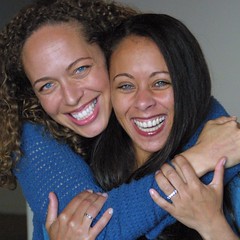 In 2007 Heidi and her longtime sister-from-a-different-mister Fanshen Cox created Mixed Chicks Chat, an award-winning weekly live call-in podcast dedicated to telling the truths of the mixed experience. Fanshen, an amazing actress, filmmaker, educator, and friend, is also mixed. Of course I listened to their podcast religiously (again the first I ever followed) and participated in the off-air chat room, calling in when I could, and before long found myself thoroughly involved in the wonderful burgeoning Mixed Chicks community, which is bizarre because I am neither mixed nor a chick but somehow it makes sense. Drop by some time; I’ll introduce you around. In 2008 these two amazing women with the help of a tireless cast of volunteers produced the first Mixed Roots Film and Literary Festival, an annual event at the Japanese American National Museum in Los Angeles celebrating Loving Day with films, readings, workshops, and family activities focusing on the untold stories of being mixed. I flew down to L.A. for the inaugural festival to help out and meet them both in person after months of amiable but purely online interaction. I tell you all this (a) to plug the Mixed Chicks, and (b) to paint a picture of my high regard and ongoing involvement with Heidi and Fanshen.
In 2007 Heidi and her longtime sister-from-a-different-mister Fanshen Cox created Mixed Chicks Chat, an award-winning weekly live call-in podcast dedicated to telling the truths of the mixed experience. Fanshen, an amazing actress, filmmaker, educator, and friend, is also mixed. Of course I listened to their podcast religiously (again the first I ever followed) and participated in the off-air chat room, calling in when I could, and before long found myself thoroughly involved in the wonderful burgeoning Mixed Chicks community, which is bizarre because I am neither mixed nor a chick but somehow it makes sense. Drop by some time; I’ll introduce you around. In 2008 these two amazing women with the help of a tireless cast of volunteers produced the first Mixed Roots Film and Literary Festival, an annual event at the Japanese American National Museum in Los Angeles celebrating Loving Day with films, readings, workshops, and family activities focusing on the untold stories of being mixed. I flew down to L.A. for the inaugural festival to help out and meet them both in person after months of amiable but purely online interaction. I tell you all this (a) to plug the Mixed Chicks, and (b) to paint a picture of my high regard and ongoing involvement with Heidi and Fanshen.
 Heidi’s publisher announced the book would come out in February, 2010, Black History Month of Barack Obama’s second year in office. Perfect. In January the advance copies were circulating, getting rave reviews, and the publisher was pushing it hard to booksellers. Awesome. Not content with their considerable efforts however, I went to the Stanford Bookstore on January 16 (I was in the area) and asked their information desk if they were going to carry it. The employee wasn’t sure so I got the contact info for their buyer. Cool. I was about to head home, when I succumbed to a slightly crazy urge to go a little further north to Kepler’s Books in Menlo Park. I asked their information guy the same question, were they planning to carry The Girl Who Fell from the Sky when it came out the following month. He typed a search into his computer then replied, “We have it in stock. It’s on this new releases table right here.” Sure enough, there it was, nearly a month ahead of the release date. I was flabbergasted. Incredulous. Elated. I couldn’t believe my good fortune, having the honor of being among the first on the planet to buy the book. It was Cosmic perfection that this happened on El Camino. I bought three copies (I gave two away to family), DMed Heidi on Twitter, raced home, and finally, three and a half years after I first read the teaser from the manuscript, read the full novel, finishing it in three days.
Heidi’s publisher announced the book would come out in February, 2010, Black History Month of Barack Obama’s second year in office. Perfect. In January the advance copies were circulating, getting rave reviews, and the publisher was pushing it hard to booksellers. Awesome. Not content with their considerable efforts however, I went to the Stanford Bookstore on January 16 (I was in the area) and asked their information desk if they were going to carry it. The employee wasn’t sure so I got the contact info for their buyer. Cool. I was about to head home, when I succumbed to a slightly crazy urge to go a little further north to Kepler’s Books in Menlo Park. I asked their information guy the same question, were they planning to carry The Girl Who Fell from the Sky when it came out the following month. He typed a search into his computer then replied, “We have it in stock. It’s on this new releases table right here.” Sure enough, there it was, nearly a month ahead of the release date. I was flabbergasted. Incredulous. Elated. I couldn’t believe my good fortune, having the honor of being among the first on the planet to buy the book. It was Cosmic perfection that this happened on El Camino. I bought three copies (I gave two away to family), DMed Heidi on Twitter, raced home, and finally, three and a half years after I first read the teaser from the manuscript, read the full novel, finishing it in three days.
 This post is quite long so I won’t talk too much about the novel itself. It has been covered at length in national press including the New York Times, Washington Post, Christian Science Monitor, and NPR. TV is next; Oprah, we’re comin’ for ya. It’s lighting up the blogosphere and vlogosphere, and it’s climbing the sales charts. This is a fun time. I will say this: I loved the book. It’s beautifully written, it tells an important, heartbreaking story, and I’m incredibly proud of Heidi. There were passages, including the climax, where time seemed to stop as I was reading because I was so consumed by the prose. This is high praise for art in any form. The most valuable gift to me is that because I’ve been getting to know Heidi these past few years, hearing her voice and her stories, I was able to inhabit the book in a way I’ve never experienced before. I knew what she was talking about. Go get it and read it; it’s widely available online and at your favorite independent and chain bookstores. Join our online community. If you can, go to her readings this week or check her book tour schedule for one near you. Seeing her eyes, hearing her voice, and getting her autograph will enhance your enjoyment of the book.
This post is quite long so I won’t talk too much about the novel itself. It has been covered at length in national press including the New York Times, Washington Post, Christian Science Monitor, and NPR. TV is next; Oprah, we’re comin’ for ya. It’s lighting up the blogosphere and vlogosphere, and it’s climbing the sales charts. This is a fun time. I will say this: I loved the book. It’s beautifully written, it tells an important, heartbreaking story, and I’m incredibly proud of Heidi. There were passages, including the climax, where time seemed to stop as I was reading because I was so consumed by the prose. This is high praise for art in any form. The most valuable gift to me is that because I’ve been getting to know Heidi these past few years, hearing her voice and her stories, I was able to inhabit the book in a way I’ve never experienced before. I knew what she was talking about. Go get it and read it; it’s widely available online and at your favorite independent and chain bookstores. Join our online community. If you can, go to her readings this week or check her book tour schedule for one near you. Seeing her eyes, hearing her voice, and getting her autograph will enhance your enjoyment of the book.
Kepler’s won the day but ever since I read those pre-published manuscript pages in 2006, I’ve visualized Heidi reading and signing her books at the Stanford Bookstore. The bookstore cuts an elegant symbol, the busy crossroads at the heart of the campus where we intersected only incidentally twenty years ago but left just enough of an impression to build a friendship on years later. Now that the vision is coming true, it brings full-circle the arcs of our two stories, but not to closure. This Ferris Wheel ride isn’t done turning.
Book Readings & Signings
Heidi Durrow, author
The Girl Who Fell from the Sky
White Plaza, Stanford University
Wednesday, April 7, 2010 5:30 pm
1010 El Camino Real
Menlo Park, CA 94025
Thursday, April 8, 2010 7:30 pm
Dessert served compliments of Anna’s Cookies of San Francisco
 I first heard of Bike Party last year when they rode past my house in the middle of the night. I was asleep in bed when I was awakened by a couple neighborhood dogs barking their heads off. I could hear voices and strange mechanical noises coming from outside in the street. That’s not so unusual; it’s a busy street and occasionally we’ll have boisterous pedestrians or vehicles going by. But this time the noises didn’t stop and the dogs kept on barking so I went to the window to see what was going on and slipped into the Twilight Zone. There were bicycles rolling down the street. Wave after wave of bicycles. Dozens of them. There were mountain bikes, road bikes, stunt bikes and beaters, riders in costumes, hipster types, and nerds in reflective vests. I thought I was dreaming. I went outside in my pajamas and found a couple teens from the neighborhood already standing on the curb, watching the spectacle. They’re the ones who told me it was Bike Party, being much hipper than I.
I first heard of Bike Party last year when they rode past my house in the middle of the night. I was asleep in bed when I was awakened by a couple neighborhood dogs barking their heads off. I could hear voices and strange mechanical noises coming from outside in the street. That’s not so unusual; it’s a busy street and occasionally we’ll have boisterous pedestrians or vehicles going by. But this time the noises didn’t stop and the dogs kept on barking so I went to the window to see what was going on and slipped into the Twilight Zone. There were bicycles rolling down the street. Wave after wave of bicycles. Dozens of them. There were mountain bikes, road bikes, stunt bikes and beaters, riders in costumes, hipster types, and nerds in reflective vests. I thought I was dreaming. I went outside in my pajamas and found a couple teens from the neighborhood already standing on the curb, watching the spectacle. They’re the ones who told me it was Bike Party, being much hipper than I. I reflected on how tragically unhip I am. I drove my car to try to get a look at a celebration of bikes, and missed the whole thing. Ironic and sad. I drove over to the ride’s end at Sunnyvale Town Center and strolled up and down South Murphy Avenue to see if I could spot any riders enjoying a post-ride beverage at the many nighttime watering holes there, but all I saw was this well-populated rack. As it so happened several bars had the Sharks’ hockey playoff game against the Colorado Avalanche at HP Pavilion on their TVs, and as I was walking back to my car I heard the whole street erupt in cheers as Devin Setoguchi scored the game-winning goal in overtime to even the series 1-1, thrilling the home crowd. Friday night on El Camino the good times just rolled.
I reflected on how tragically unhip I am. I drove my car to try to get a look at a celebration of bikes, and missed the whole thing. Ironic and sad. I drove over to the ride’s end at Sunnyvale Town Center and strolled up and down South Murphy Avenue to see if I could spot any riders enjoying a post-ride beverage at the many nighttime watering holes there, but all I saw was this well-populated rack. As it so happened several bars had the Sharks’ hockey playoff game against the Colorado Avalanche at HP Pavilion on their TVs, and as I was walking back to my car I heard the whole street erupt in cheers as Devin Setoguchi scored the game-winning goal in overtime to even the series 1-1, thrilling the home crowd. Friday night on El Camino the good times just rolled.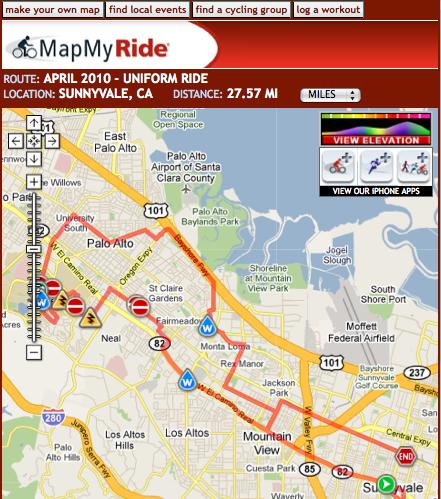





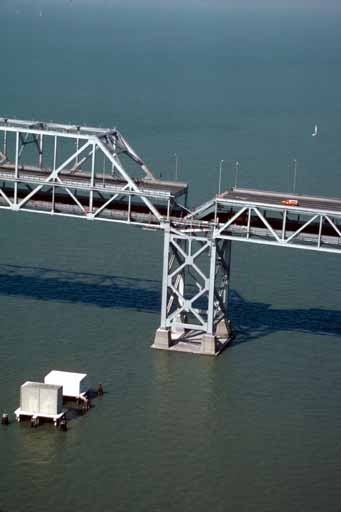 Over the next few hours and days news came in of the magnitude of the quake’s devastation throughout the region. The horror of the
Over the next few hours and days news came in of the magnitude of the quake’s devastation throughout the region. The horror of the 